Something went wrong!
Hang in there while we get back on track
Best attractions in Palermo

With its unique Arab-Norman architectural style, the Cathedral captivates the eye of any visitor. Admire the unconventional exterior, adorned with elegant arches, detailed Islamic-style geometric patterns and richly decorated towers. For breathtaking panoramic city views, climb to the rooftop during sunset. It’s one of the city’s top experiences.
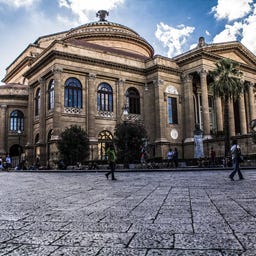
Teatro Massimo stands as a monumental opera house, celebrated for its grandeur and acoustic excellence. As Italy's largest and Europe's second-largest opera venue, it is a cornerstone of cultural heritage, famous not only for its neoclassical elegance but also as a filming location for notable movies like "The Godfather: Part III".
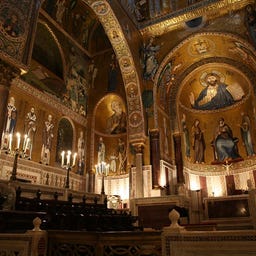
The chapel from the 12th century, a stunning example of Norman architecture, is Palermo's top attraction. It impresses with its fine Byzantine gold mosaics, an exquisite ceiling in the Arabic style, and beautiful marble inlays. This unique combination reflects the cultural fusion of Sicily under Norman rule. You'll find this gem on the middle level of the Palazzo dei Normanni.
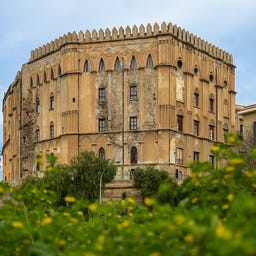
The Norman Palace is Europe’s oldest royal residences and a must-see in Palermo. Originally erected as a 9th-century Arab fortress, the Normans expanded it into a striking example of medieval architecture. The highlight is the Palatine Chapel, renowned for its exquisite Byzantine artistry, with dazzling gold mosaics and intricate Arabic-style woodwork. The best rooms within the Royal Apartments are the mosaic-lined Sala dei Venti and King Roger's 12th-century bedroom, Sala di Ruggero II. The botanical palace gardens with their tropical trees offer you a place to rest before you venture out again.
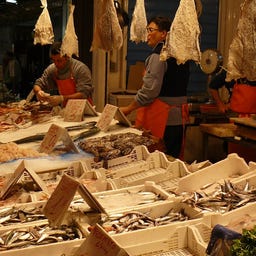
Dive into the heart of Sicilian culture and sample the delicious street food. Mercato di Ballarò, the largest among Palermo's markets, carries a rich history dating back to Arab times. Here, the air is filled with the scent of local spices, and the tantalizing aromas of Sicilian street food. From the iconic arancini (rice balls) to pane e panelle (famous chickpea fritters), and crocche, potato croquettes, every bite is a treat.

Quattro Canti, also known as Piazza Vigliena, is a renowned Baroque square located in the heart of Palermo. Positioned at the intersection of Via Maqueda and Corso Vittorio Emanuele, it forms the heart of the city's four ancient quarters: Kalsa, Seralcadi, Albergaria, and Castellammare.
Constructed between 1608 and 1620 by architects Giulio Lasso and Mariano Smiriglio, Quattro Canti features an octagonal design. The square's architecture showcases nearly symmetric, concave facades, each divided in three classical orders and beautifully embellished with statues:
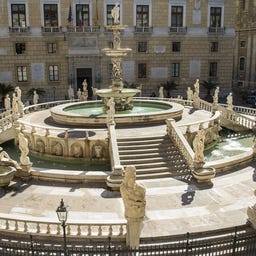
In the heart of Palermo's historic center, you'll find the Fontana di Piazza Pretoria, one of the most elaborate fountain complexes in Italy. This monumental fountain, created in 1554 by Francesco Camilliani in Florence and transported to Sicily in 644 individual pieces in 1574, impresses with its pyramid-shaped design featuring 48 intricately detailed statues of mythological figures.

In the Chiesa del Gesù, also known as the Casa Professa, you will find one of the most significant Baroque churches in Palermo, built between 1590 and 1636. This impressive church, inspired by the Roman Gesù Church, features a single-nave architecture with large side chapels and elaborate marble and stucco decorations inside.
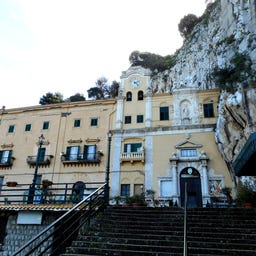
High above Palermo, at an altitude of 429 meters, stands the Santuario di Santa Rosalia, a fascinating sanctuary from the 17th century built directly into a rock niche. The discovery of the remains of Santa Rosalia in 1624, who, according to tradition, helped the city overcome the plague, turned this already revered site, known as holy since the 13th century, into the most important pilgrimage destination in Palermo.
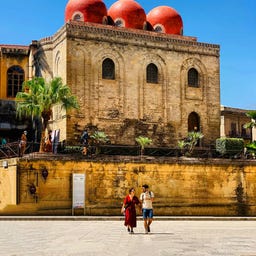
The Chiesa di San Cataldo in Palermo is one of the most impressive examples of Arab-Norman architecture in Sicily, recognizable by its distinctive three red domes and the compact sandstone facade with Islamic-inspired blind arches. Founded between 1154 and 1160 by Majone di Bari, the church has a tumultuous history, having served as a Benedictine monastery and later as a post office in the 19th century.

In the Chiesa della Martorana in the historic center of Palermo, you will find a fascinating blend of Byzantine, Norman, and Baroque architecture. Founded in 1143 by Giorgio d'Antiochia, a Byzantine admiral in the service of the Norman king Roger II., the church has been a UNESCO World Heritage Site since 2015, recognized for its Arab-Norman architectural monuments in Palermo.
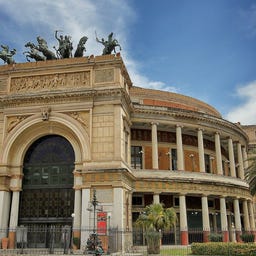
The Teatro Politeama Garibaldi in the heart of Palermo is one of the most important theaters in Sicily, embodying the cultural spirit of the city since its opening in 1874. The impressive building, designed by architect Giuseppe Damiani Almeyda, features a semi-circular façade with a triumphal arch entrance, topped by a bronze quadriga of Apollo created by artist Mario Rutelli.
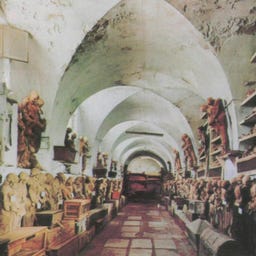
The underground cemetery, established in the 16th century, houses over 8,000 mummified bodies, dressed in their finest clothes and displayed along the walls. The catacombs provide a macabre yet insightful glimpse into Sicilian cultural practices, beliefs about death, and the methods of preserving the deceased. A visit is certainly not for the faint-hearted but undeniably offers an extraordinary experience.
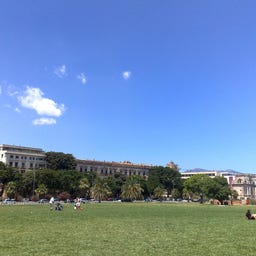
On the coast of Palermo, you'll find the Foro Italico, a vast green space covering 40,000 m² of lawn that stretches from the La Cala harbor to the Villa Giulia in the Kalsa district.

The Riserva Naturale Orientata Capo Gallo is a 586-hectare nature reserve on the Sicilian coast that has been protected since 2001. In this diverse habitat, you can find endemic species like the Sicilian shrew and a unique coastal formation made of mollusk shells, known as "Trottoir a Vermeti." Caves shaped by the sea, such as the Grotta dell'olio, and archaeological sites reflect the rich history of the area. You can explore the restored hiking trails and discover the natural beauty of the reserve via various access routes, such as from Torre di Mondello or Contrada Barcarello.
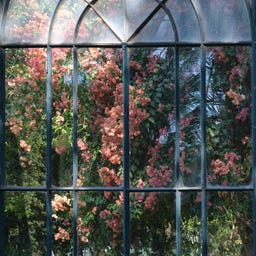
In the Orto botanico di Palermo, one of the most significant botanical gardens in Italy, you can explore over 12,000 different plant species spread across 10 hectares of park-like grounds. Founded in 1779 as a medicinal herb garden, the park impressed Johann Wolfgang von Goethe during his visit in 1787, calling it a "magical place."
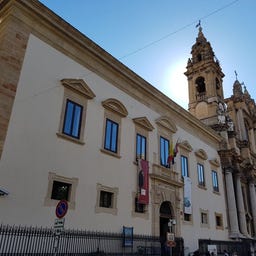
In the former monastery building from the 16th/17th century, you will find one of the most significant archaeological collections in Italy, documenting the history of Sicily from prehistoric times to the Middle Ages. The museum, named after the archaeologist Antonino Salinas, houses impressive artifacts from various cultures - from the Phoenicians to the Greeks and Romans - and was reopened in 2016 after extensive renovations.
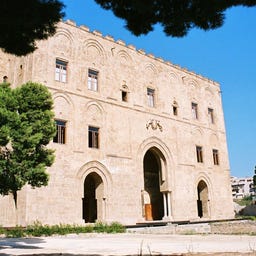
In the west of Palermo stands La Zisa, a fascinating Norman-Arab palace from the 12th century, whose name comes from the Arabic "al-ʿAzīza" (the Magnificent). Built as a summer residence by King William I. starting in 1165, it uniquely combines Arab and Norman architectural elements and features a sophisticated ventilation system that makes optimal use of sea breezes. You can particularly appreciate the former splendor of the palace in the famous Sala della Fontana, with its ornate vaulted ceiling and decorative niches. Today, this meticulously restored building, which became a UNESCO World Heritage site in 1991, houses the Museum of Islamic Art.

As a monumental city gate, the Porta Nuova has marked the most important land access to Palermo since the 15th century and serves as the starting point of the Corso Vittorio Emanuele, the main street of the Sicilian metropolis. The magnificent triumphal arch, which stands right next to the Palazzo dei Normanni, was erected in 1583 by Viceroy Marcantonio Colonna to commemorate the victories over the Turkish forces. After a devastating explosion caused by a lightning strike in 1667, the structure was rebuilt two years later by architect Gaspare Guercio and now impresses with its three-story architecture, white marble loggias, and intricate decorations, including four statues of defeated Moors.

In the historic Kalsa district of Palermo, you will find the Giardino Garibaldi, a green oasis from the 1860s created in honor of the national hero Giuseppe Garibaldi. Designed by Giovan Battista Filippo Basile, the garden is home to the largest Ficus in Europe—an impressive specimen standing 30 meters tall with a crown spread of 50 meters in diameter.
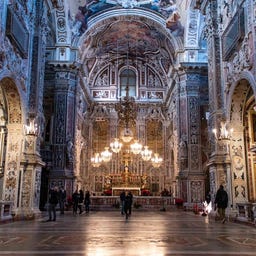
In the historic center of Palermo stands the Chiesa di Santa Caterina, an impressive testament to the Counter-Reformation with its late Baroque façade and grand staircase. Originally founded in 1310 and rebuilt in the 16th century, this church captivates with its lavish interior featuring marble, stucco, and frescoes, including the famous ceiling painting "Triumph of Santa Caterina" by Filippo Randazzo.
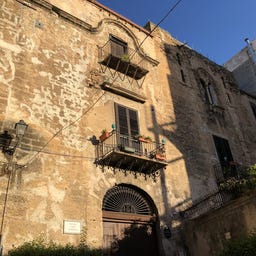
In the heart of Palermo stands the Palazzo Conte Federico, one of the oldest noble palaces in the city, still inhabited by Count Alessandro Federico. This impressive building houses the Torre Busuemi from the 12th century, an Arab-Norman tower that incorporates a former city gate.
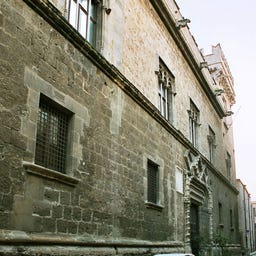
The 15th-century Palazzo Abatellis houses the Regional Gallery of Sicily, showcasing a wide array of Sicilian art from the Middle Ages to the 18th century. It is considered the best art museum in Palermo. The museum's highlights are the Triumph of Death fresco in the former palazzo chapel, a vivid representation of Death as a demonic skeleton, and Antonello da Messina's Virgin Annunciate, blending Italian and Flemish artistic influences. These pieces, among others, offer visitors deep insights into the evolution of art in Sicily.
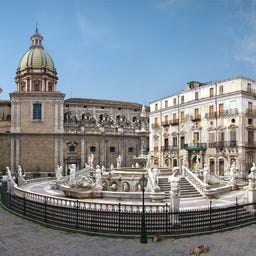
In the heart of Palermo, you will find Piazza Pretoria with its famous Fontana Pretoria - a monumental fountain from the 16th century, created by Francesco Camilliani. Originally intended for Florence, the fountain was acquired by the Senate of Palermo in 1573 and installed here in 1581 after extensive renovations.

The Chiesa di San Francesco di Paola beautifully combines Catalan Gothic, Mannerism, and Baroque styles into an architectural masterpiece from the 16th century. Built on the site of an older church from 1310, the current structure impresses with its single-nave layout, deep side chapels, and magnificent Baroque decorations.
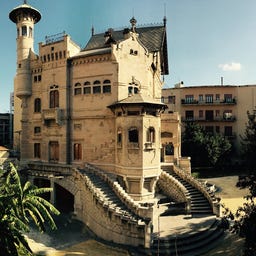
In the heart of Palermo, you discover the Villino Florio, one of the first and most significant examples of Italian Art Nouveau, created between 1899 and 1902 by architect Ernesto Basile for the wealthy Florio family.
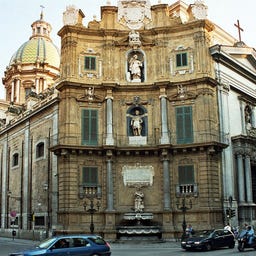
The Chiesa di San Giuseppe dei Teatini is one of the most significant Baroque churches in the historic center of Palermo, majestically situated between the Piazza Pretoria and the Quattro Canti. Built in the early 17th century by Pietro Caracciolo, the church impresses with its magnificent interior, featuring frescoes by Antonio Manno, Filippo Tancredi, and Guglielmo Borremans, as well as an imposing altar made of black marble. In the accessible crypt, you can find a water source that has been attributed with miraculous powers for centuries. After suffering severe damage during World War II, the church has been restored multiple times and is now not only an active place of worship but also an impressive testament to Sicilian church architecture.

Majestically, Monte Pellegrino rises as a 606-meter high limestone rock above the Sicilian capital Palermo - a place that Johann Wolfgang von Goethe described in the 18th century as the "most beautiful promontory in the world." The mountain combines a fascinating history, from prehistoric settlements in the Addaura Cave to its role as a strategic fortress during the First Punic War.
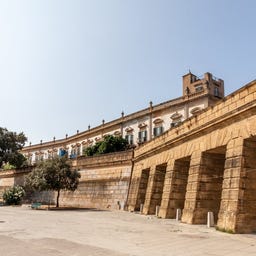
In the historic district of Kalsa stands the impressive Palazzo Butera, which, with its distinctive two-tone facade, is visible from the harbor and offers a stunning view over the Foro Italico and the Gulf of Palermo. Built in the late 17th century by the Branciforte family, the palace was acquired in 2016 by Massimo and Francesca Valsecchi after centuries of family ownership and has been meticulously restored.
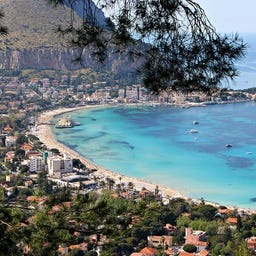
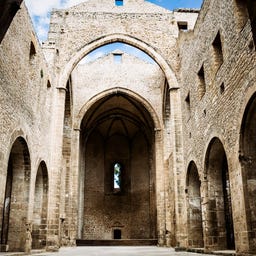
temporarily closed for restoration work
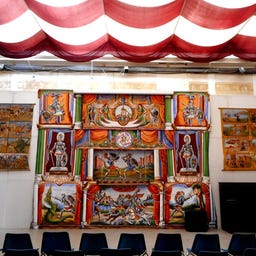
At the Museo internazionale delle marionette Antonio Pasqualino, you will find one of the world's most significant collections of traditional puppet art, featuring over 5,000 marionettes, dolls, and shadow figures from around the globe. Founded in 1975 by Antonio Pasqualino, the museum houses the largest collection of Sicilian puppets and has been recognized by UNESCO as a "Masterpiece of the Oral and Intangible Heritage of Humanity."
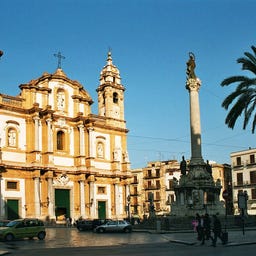
As the second most important church in Palermo after the Cathedral, the Chiesa di San Domenico impresses with its grand Baroque facade featuring two tall bell towers and numerous statues of saints. Built between 1458 and 1480, the church combines Gothic and Sicilian Baroque architectural elements and, with an area of 3,600 m², is one of the largest places of worship in Sicily.

With its distinctive red domes, the Chiesa di San Giovanni degli Eremiti is one of the most fascinating examples of Arab-Norman architecture in Palermo. Originally founded in the 6th century by San Gregorio Magno, the church was rebuilt as a Christian place of worship by King Roger II after its destruction by the Saracens in 1132.
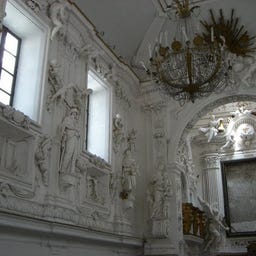
In the historic center of Palermo, you will find the Oratorio di San Lorenzo, a baroque gem from the late 16th century, famous for its extraordinary stuccoes by Giacomo Serpotta.
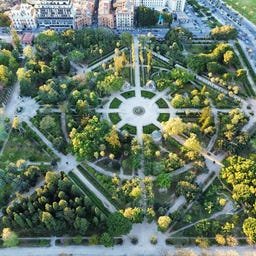
In the Villa del Popolo, a romantic city garden from the late 18th century, you will find a green oasis of tranquility between Via Lincoln and the Foro Italico. The garden, designed by Nicolò Palma, impresses with its symmetrical layout featuring four perfectly square sections and a striking neoclassical entrance portal with Doric columns.
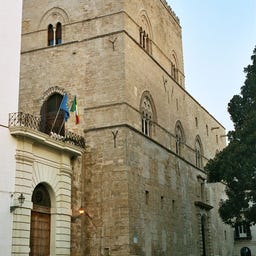
The impressive Palazzo Chiaramonte-Steri in the heart of Palermo combines Norman and Gothic architectural elements in a striking way and reflects Sicily's tumultuous history. Built in the early 14th century as the residence of the Chiaramonte family, the fortified palace later served as the seat of the Sicilian viceroys and housed the feared Inquisition tribunal from 1600 to 1782.
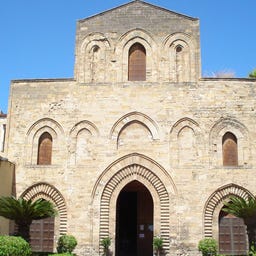
In the Basilica La Magione, one of the oldest churches in Palermo, you will find a fascinating example of Arab-Norman architecture from the 12th century. Originally built as a mosque and completed in 1191, the church became a significant religious center under Matteo da Salerno, where even King Tancredi of Sicily found his final resting place.

In the historic center of Palermo, behind a simple facade, lies one of the most impressive examples of Sicilian Baroque art from the 17th century. The Oratorio del Rosario di Santa Cita was founded in 1570 by the Rosary Brotherhood and was adorned between 1686 and 1718 by Giacomo Serpotta with dynamic angels and cherubs in exquisite stucco.
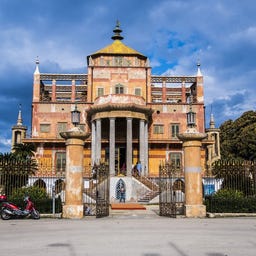
On the edge of the expansive Parco della Favorita, you will find the Palazzina Cinese, an extraordinary testament to Sicilian architectural history. Built starting in 1799 by Giuseppe Venanzio Marvuglia for Ferdinand III of Sicily, the palace captivates with its unique oriental style featuring a pagoda roof and pointed arches.
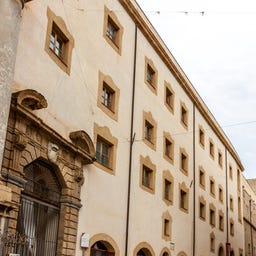
In the historic Kalsa, the oldest district of Palermo, you will find the Galleria d'Arte Moderna, which boasts an impressive collection of Southern Italian art from the late 18th to the early 20th century. Founded in 1910 by Empedocle Restivo, the museum has been located since 2006 in a meticulously restored 17th-century complex that combines a former Franciscan monastery with the Catalan-Gothic Palazzo Bonet.
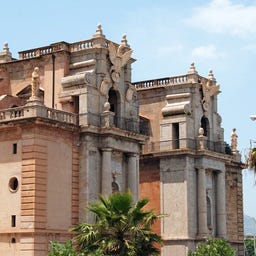
The Porta Felice is one of the most important historical city gates of Palermo and serves as the monumental entrance from the sea to the central Cassaro Boulevard. The construction, which began in 1582 under Viceroy Marcantonio Colonna and was completed in 1637, combines elements of Renaissance and Baroque architecture, with the seafront facade particularly adorned with gray marble decorations, statues, and loggias.
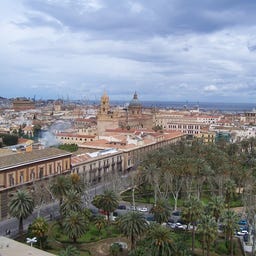
In the historic center of Palermo, Circoscrizione 1, you can experience the fascinating history of the Sicilian capital from its Phoenician beginnings to the Italian unification up close. The four traditional neighborhoods (Mandamenti) - Kalsa, Albergheria, Seralcadio, and La Loggia - are home to significant UNESCO World Heritage sites along the Arab-Norman route, including the magnificent Cappella Palatina and the Palazzo dei Normanni.
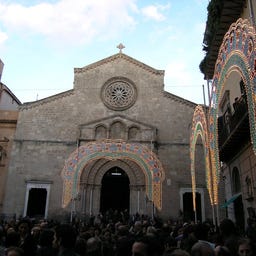
In the historic old town of Palermo stands the Chiesa di San Francesco d'Assisi, a Gothic basilica with a history dating back to 1224, during the lifetime of Saint Francis of Assisi himself.
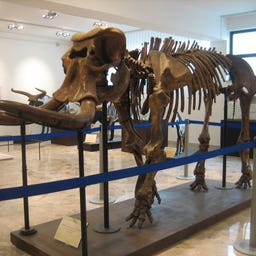
In the historic university museum founded by Gaetano Giorgio Gemmellaro in 1866, you can embark on a fascinating journey through Sicily's geological history. After a tumultuous past marked by earthquakes and war damage, the museum has been showcasing its exhibits in a modern setting with expanded display areas since 2005 on Corso Tukory.
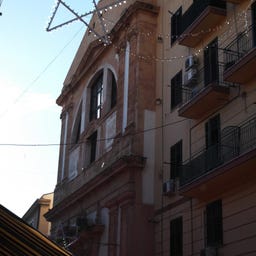
In the bustling Capo Market of Palermo stands the Chiesa dell'Immacolata Concezione, an impressive Baroque church from the early 17th century. Originally built as part of a Benedictine monastery, which took over 100 years to complete, it captivates with its austere Roman-Baroque facade and a magnificent interior adorned with marble.

In the Giardino Inglese, a public park in the heart of Palermo, you will find one of the most beautiful gardens designed in the English landscape style of the 19th century. The garden, created in 1851 by Giovan Battista Filippo Basile, impresses with its natural design featuring exotic plants from around the world, including rare species like dragon trees and jacaranda.
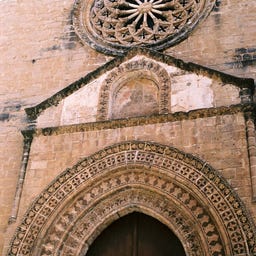
The Chiesa di Sant'Agostino, known locally as "Santa Rita," impressively combines Gothic architecture on its facade with lavish Baroque design inside. Located in the historic old town of Palermo, the church has a rich history that dates back to the 12th century, including several renovations and a significant restoration after a fire in 1663.

The impressive Ponte dell'Ammiraglio from the 12th century spans a now green park area in the east of Palermo with its twelve characteristic pointed arches. This Gothic bridge, which once crossed the Oreto River, was built around 1131 by Giorgio d'Antiochia, the admiral of King Roger II, and connects the city center with the Brancaccio district.
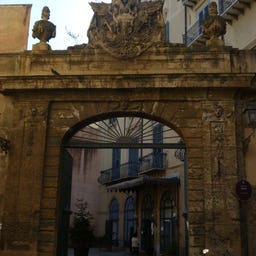
In the historic center of Palermo, the Palazzo Mirto offers you an authentic glimpse into the life of the Sicilian aristocracy. This magnificent city palace, with parts dating back to the 13th century, was home to the Filangeri family for four centuries and later to the Lanza Filangieri.
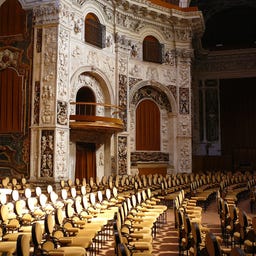
The Chiesa del Santissimo Salvatore in the historic center of Palermo combines Norman roots from the 11th century with magnificent Baroque architecture from the 18th century. Originally founded by Robert Guiscard for Basilian nuns, the church impresses today with its twelve-sided shape, elliptical dome, and elaborate interior featuring frescoes, stucco work, and marble decor.
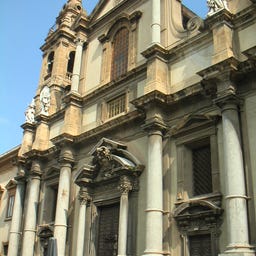
The magnificent Chiesa di Sant'Ignazio all'Olivella in the historic Rione Olivella of Palermo is one of the most significant examples of Sicilian Baroque architecture. Designed by Antonio Muttone in the early 17th century, the church impresses with its grand Baroque facade featuring two distinctive bell towers and a three-nave interior adorned with exquisite marble work.
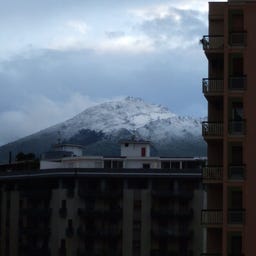
The Monti di Palermo surround the Sicilian capital like a natural horseshoe, stretching over a length of about 25 kilometers. This striking mountain range, bordered by the Eleuterio and Jato rivers, is divided into a northwestern and a southeastern sector. With Monte Gibilmesi (1,156 m) as its highest peak, the mountain chain serves as an important watershed for the surrounding coastal plains, including the Piana di Palermo. This geologically fascinating formation encompasses several valleys and plains, such as the Conca d'Oro and the Piana dei Colli.
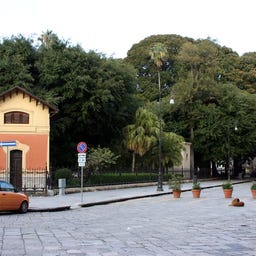
In the historic Kalsa district of Palermo, Piazza Marina transformed from a swampy area in the 14th century into one of the city's liveliest squares. At its heart is the Villa Garibaldi, designed in 1863 by Giovan Battista Filippo Basile, featuring a monumental fig tree and the baroque Fontana del Garraffo.
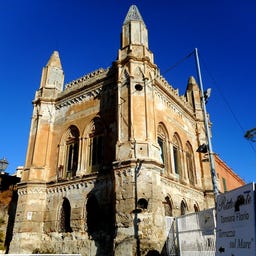
In the Arenella area of Palermo stands the Palazzina dei Quattro Pizzi, a neo-Gothic gem from 1844, distinguished by its striking four corner towers. The architect Carlo Giachery designed the building as a private residence for the influential Florio family, who hosted high-profile guests here, including the Russian royal family. The Empress was so taken with the architecture that she purchased the blueprints to create a copy in Peterhof. Until 2016, the estate, which transformed from an industrial building into an elegant villa, remained in the hands of the Florio heirs.
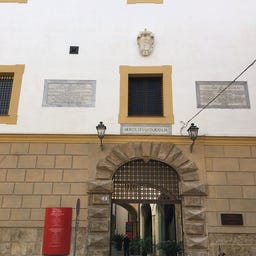
In the historic center of Palermo, you'll find the Palazzo Branciforte, a fascinating building from the 16th century that has been serving as a modern cultural center since its extensive restoration in 2012.

In the east of Palermo, you will discover the Castello di Maredolce, an architectural gem from the 12th century, built entirely in the Islamic style. Originally constructed as a residence for Emir Ja'far al-Kalbi II and later expanded by Norman King Roger II, the castle was once surrounded by an artificial lake, which gave it the name "sweet sea."
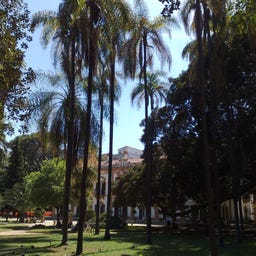
In the historic Villa Trabia, a neoclassical building from the 18th century with a spacious park, you will find a public library and a free internet café today. The magnificent garden was created starting in 1756 by Don Paolo Spinelli and received its romantic design with statues, benches, and fountains under Princess Sofia of Trabia in 1881.
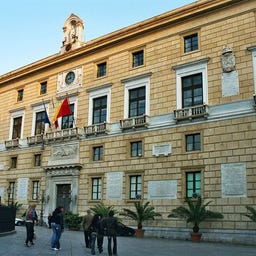
The Palazzo Pretorio, built in the 14th century under Federico II of Aragon, stands as a representative seat of the city administration at Piazza Pretoria in the heart of Palermo. In front of the residence, also known as the "Palazzo delle Aquile," lies the monumental Fontana Pretoria, while inside, magnificent halls like the Sala Rossa and the Sala delle Lapidi are lined up. After several renovations in the 16th and 17th centuries, the palace took on its current neo-Renaissance form, designed by architect Giuseppe Damiani Almeyda in 1875. The building witnessed significant historical moments as the government seat of Garibaldi during the uprising of 1860 and as a host for personalities like Pope John II.
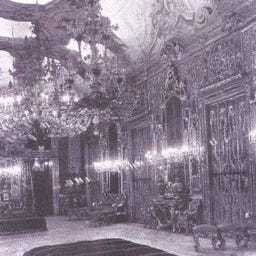
In the heart of Palermo, the Palazzo Valguarnera-Gangi awaits you as an impressive example of Sicilian Rococo architecture from the 18th century. This 8,000 square meter noble palace, built by Prince Pietro di Valguarnera, captivates with its magnificent interior, featuring a monumental staircase and the famous ballroom "Salone Giallo" with its unique openwork ceiling.

In the historic Kalsa, one of the oldest neighborhoods in Palermo, you will find the Chiesa di Santa Maria della Pietà, an impressive example of Sicilian Baroque from the 17th century. The magnificent façade combines early Palermitan and Roman Baroque styles, adorned with intricate statues of saints.
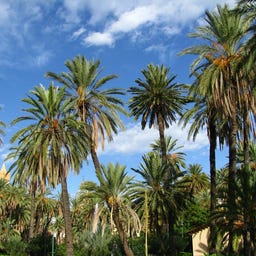
In the heart of Palermo lies the Villa Bonanno, a 30,000 square meter public garden filled with palm trees, designed in 1905 by architect Giuseppe Damiani Almeyda. Among the shade-giving trees, you can find the remains of two Roman patrician houses from the 19th century, as well as an impressive collection of monuments honoring significant figures from the city.
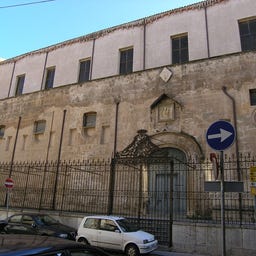
In the historic Kalsa, once the center of Muslim power in Palermo, you will find the Chiesa di Santa Maria degli Angeli - an impressive blend of Gothic and Baroque architecture. Built in the late 15th century, the church captivates with its magnificent wooden ceiling adorned with golden stars and houses twenty chapels along the main nave.
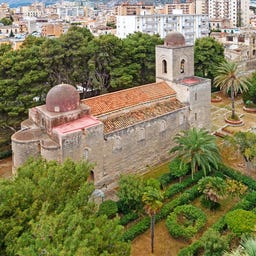
The simple Chiesa di San Giovanni dei Lebbrosi is one of the oldest medieval buildings in Palermo, built in 1071 by Robert Guiscard and Roger I during the Norman conquest. The Romanesque church in the Sicilian-Norman style impresses with its three-nave basilica, a striking transept, and Arabic inscriptions on the column capitals.

The Piazza Magione in the historic Kalsa district of Palermo is deeply intertwined with the history of Sicily. The spacious square is dominated by the impressive Basilica La Magione, which originally emerged from the Renaissance gardens of the church.
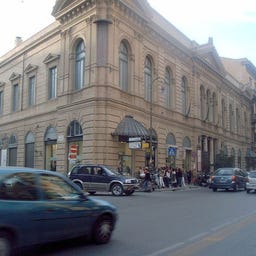
In the heart of Palermo, right on the bustling Via Roma, you’ll find the Teatro Biondo - a classic theater from the early 20th century. Opened in 1903, this magnificent building designed by Nicolò Mineo impresses with its symmetrical facade and the intricate Liberty-style decorations by Agozzino and Gregorietti inside.

In the heart of Palermo's old town stands the impressive Palazzo Alliata di Villafranca, which shapes the Piazza Bologni with its monumental facade and two symmetrical portals. Originally built in the 16th century, the palace was redesigned in the 18th century in the late Baroque style under the guidance of architect Giovanni Battista Vaccarini and houses significant artworks, including paintings by Antoon Van Dyck and Matthias Stomer.
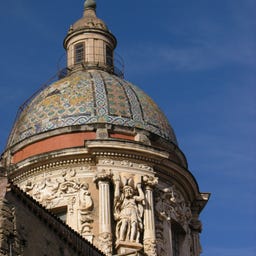
In the Chiesa del Carmine Maggiore in the Albergheria district of Palermo, you encounter an impressive church from the 17th century, whose history dates back to the arrival of the Carmelites from Palestine in 1235. The three-nave church is distinguished by its striking dome from 1680 adorned with biblical stucco figures and its simple façade crowned by a statue of the Madonna del Carmelo.
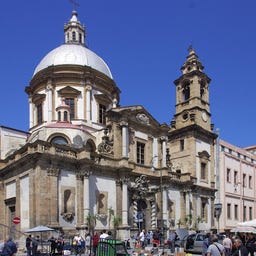
The magnificent Baroque church in the historic center of Palermo was built by Jesuits between 1680 and 1710 and captivates with its impressive dome architecture featuring a main dome and four smaller side domes.
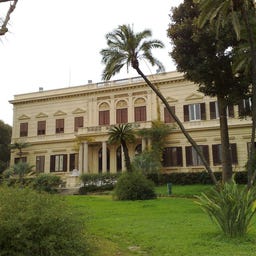
In the Villa Malfitano, an elegant city palace from the late 19th century, you will find an impressive collection of art treasures - from Flemish tapestries to exquisite furniture and paintings. The neoclassical estate, built between 1885 and 1889 by Ignazio Greco for the English merchant family Whitaker, is set within a 7-hectare park featuring rare plants from around the world.
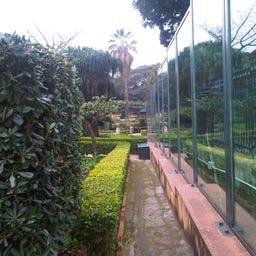
In the heart of Palermo, you will find the Parco D'Orleans, Italy's only ornithological park, which stretches right next to the magnificent Palazzo d'Orléans. What began as a private reserve in the early 19th century transformed in the 1960s, thanks to ornithologist Salvatore Lauricella, into a fascinating nature refuge that now houses 350 animals from 70 different species.
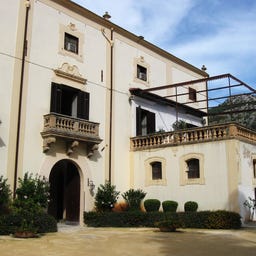
North of Palermo, you will discover the Villa Niscemi, a magnificent residence from the late 17th century, rising at the edge of the Parco della Favorita. Surrounded by bougainvilleas, this villa served as the ancestral home of the Valguarnera family for three centuries and was transformed into an elegant summer residence in the 18th century, where the famous jewelry designer Fulco di Verdura also spent his childhood.
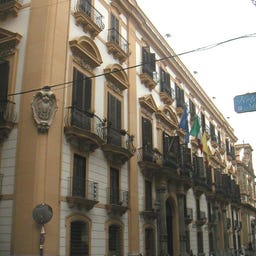
The magnificent Palazzo Comitini on Via Maqueda in Palermo combines aristocratic history with the artistic design of the 18th century. Built by Nicolò Palma between 1766 and 1781, the palace impresses with its symmetrical façade, Chinese salons, and elaborate stucco work. In the "Sala Martorana," you can admire the stunning ceiling painting "Gloria del Principe" by Gioacchino Martorana, while the floor is adorned with beautiful Neapolitan majolica tiles. Today, the Palazzo, which also houses two paintings by the Sicilian artist Renato Guttuso, serves as the administration of the Metropolitan City of Palermo.
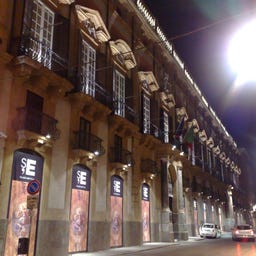
In the heart of Palermo, at Via Maqueda, you will find the Palazzo Sant'Elia, an impressive city palace that was once known as the Palazzo dei Marchesi di Santa Croce. After extensive expansions by Giovanbattista Celestri and Grimaldi di Santa Croce in the 18th century, the building became an architectural gem with intricate frescoes and stucco work.

The Castello a Mare in the harbor district of Palermo reflects the tumultuous history of the Sicilian capital: Originally built in the 9th century by the Arabs as a harbor fortress, it was expanded into a powerful castle complex under the Normans Robert Guiscard and Roger the Great.
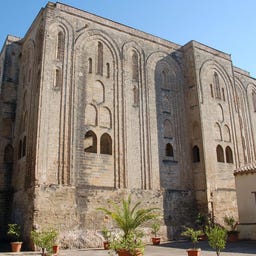
In the heart of Palermo, the Palazzo della Cuba awaits you as a fascinating example of Arab-Norman architecture from the 12th century. This rectangular masterpiece was built in 1180 by King William II as a pleasure pavilion amidst a paradise garden and gets its name from the Arabic word "Qubba," meaning dome.
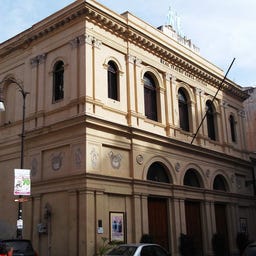
In the historic center of Palermo, you will find the Teatro Santa Cecilia, one of the most traditional theaters in Sicily, which opened its doors in 1693 and has been used as a cultural center again since 2016 after extensive restoration. The elegant theater building impresses with its elliptical hall featuring 66 boxes across four tiers, which once served as private retreats for the local aristocracy. Throughout its eventful history, the building designed by Giuseppe Musso has not only functioned as a theater but also as a ballroom, café-chantant, and even a wax museum before temporarily closing in 1888. Today, you can mainly enjoy jazz concerts and cultural events here, organized by the Brass Group Foundation.
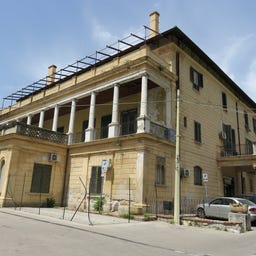
In the elegant Villa Sofia in the Resuttana-San Lorenzo district of Palermo, you will find an impressive testament to the Anglo-Sicilian history of the 19th century. Originally built by the Marquises Mazzarino, the estate was acquired by Joseph Whitaker in 1850 and named after his wife.
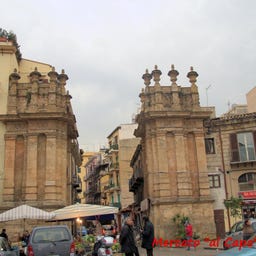
The Porta Carini is one of the oldest city gates of Palermo and welcomes you today in a neoclassical style with four false columns and Doric capitals. Built from limestone, the gate was first documented in 1310 and has undergone several transformations over the centuries—most notably, it was completely rebuilt in 1782, when it was reconstructed further north without an archway.
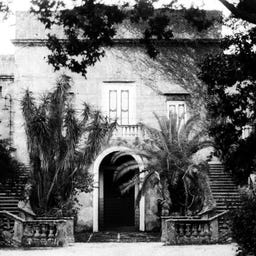
In the Piana dei Colli, the former summer residence area of the Palermitan nobility, you will find the impressive Villa Boscogrande from the late 18th century. Built by the Duke of Montalbo, the villa showcases the architectural transition from Baroque to Neoclassicism.
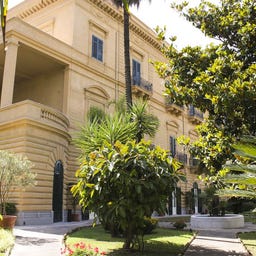
In the magnificent Villa Zito, a noble palace from the early 18th century in the heart of Palermo, you will find an impressive art collection with over 300 works. Originally built by Francesco Scicli and later acquired by Francesco Zito, the palace was transformed into a modern art gallery in 2015, spanning over 1,000 square meters.
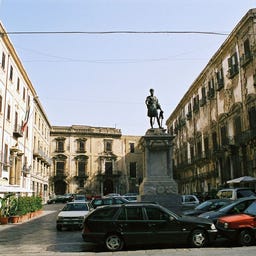
In the heart of the historic Albergheria district of Palermo, you will find the rectangular Piazza Bologni, which was established in 1566 by Viceroy Carlo d'Aragona Tagliavia. At the center of the square stands the impressive bronze statue of Emperor Charles V, erected here in 1631 to commemorate his triumphant campaign in Tunis in 1535.
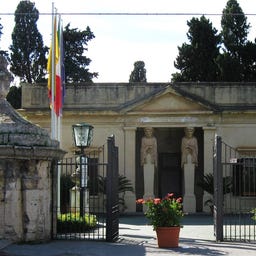
In the heart of Palermo, you will find the charming Teatro di Verdura, an open-air theater in a horseshoe shape, nestled within the historic gardens of the Villa Castelnuovo. Designed by architect Antonio Gentile, the theater features a neoclassical entrance with two impressive telamons and a remarkable octagonal fountain topped by the statue "Armonia" by artist Ignazio Marabitti.
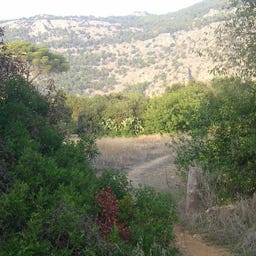
The Parco della Favorita is the largest park in Palermo, covering 4 km², and was established in 1799 by King Ferdinand III of Bourbon as a royal hunting ground. At the heart of the park stands the Palazzina Cinese, an exotic villa in oriental style, while at the end of the main avenue, a neoclassical fountain featuring a statue of Hercules impresses visitors.
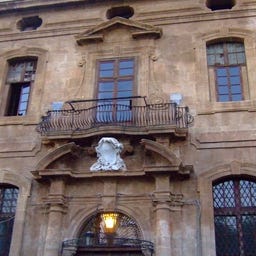
The impressive Albergo dei Poveri on Corso Calatafimi was built between 1746 and 1772 as a poorhouse and orphanage and is considered one of the most significant social buildings of the 18th century in Palermo. Designed by architects Orazio Furetto, Giuseppe Venanzio Marvuglia, and Nicolò Puglia, the complex features a striking stone facade with an intricately designed portal, as well as a magnificent staircase and the church Santa Maria della Purificazione.

In the heart of Palermo, on Via Roma, you’ll find the historic Piazza San Domenico, shaped since the 17th century by the impressive Chiesa di San Domenico and the baroque Colonna dell'Immacolata. Once known as Piano Imperiale, the square became a bustling thoroughfare in the 19th century with the construction of Via Roma, leading you directly to the traditional Vucciria market.

In the historic Kalsa district of Palermo stands the impressive palace from the late 17th century, which was once built on Spanish fortifications to defend against pirate attacks. Here lived the famous Sicilian writer Giuseppe Tomasi di Lampedusa, author of the classic "Il Gattopardo," whose life and work are now celebrated in a museum on the noble floor.
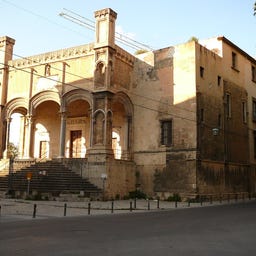
The Chiesa di Santa Maria della Catena in Palermo uniquely combines Gothic-Catalan style with Renaissance elements and was built between 1490 and 1520 under the guidance of Matteo Carnilivari.
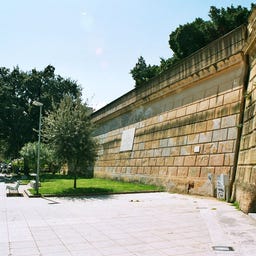
The ancient city walls of Palermo are a fascinating testament to the tumultuous history of the Sicilian capital, spanning from Punic-Roman fortifications to Norman expansions. Along Corso Alberto Amedeo and behind the Teatro Massimo, you can still find well-preserved sections of the historic walls that once protected the city with nine gates and a sophisticated system of watchtowers. On the Passeggiata delle Cattive, you can take a picturesque walk along the walls, while the restored Castello a Mare at the harbor now attracts new visitors as an archaeological park. The walls tell the story of various rulers and eras—from the Punics to the Arabs and the Normans, who entered the city through the Porta Sant'Agata in 1071.
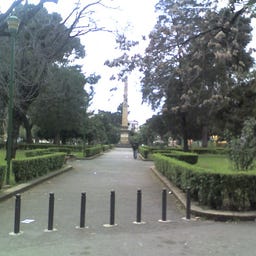
The Piazza Indipendenza is one of the most important squares in Palermo, located right in front of the magnificent Palazzo dei Normanni. Here, you’ll find not only a spacious garden in the center but also significant government buildings like the Palazzo d'Orleans, which houses the Sicilian regional government.

The baroque Chiesa di Sant'Anna la Misericordia is one of the most significant church buildings in Palermo, constructed between 1606 and 1632 in honor of Saints Anna and Joachim. Inside, you will find three naves separated by gray marble columns, as well as an impressive false dome that serves as a ceiling decoration.
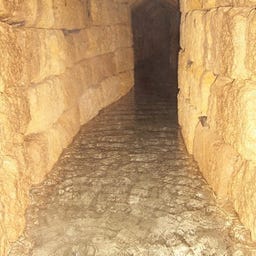
Deep beneath the streets of Palermo lies a fascinating network of historical water channels - the Qanat di Palermo. These impressive underground waterworks were created during the Arab and Norman rule, serving not only as a water supply but also as a natural air conditioning system on hot Scirocco days.

In the east of Palermo, you discover the Parco della Favara, a green oasis that was once part of the royal "Sollazzi Regi" and was created by King Roger II. before 1153. The expansive park, with its artificial lake and lush gardens, still covers 25 hectares today and is home to the historic Castello di Maredolce.
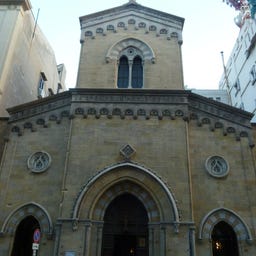
The Chiesa dei Santi Pietro e Paolo, built between 1865 and 1880 according to plans by Domenico Marvuglia, impresses with its neo-Romanesque facade featuring three pointed arches. Inside, which is inspired by the late Gothic style of the nearby Santa Maria della Catena, you will find three nave spaces adorned with frescoes and intricately designed altars by the painter G. La Manna.

In the historic center of Palermo, you will find the Palazzo Drago Ajroldi di Santacolomba, an impressive city palace that reflects the architectural development from Sicilian Baroque to Art Nouveau. Originally built as an Arab fortress, the palace came into the possession of Casimiro Drago in 1714 and was later taken over by the Ajroldi family in the 19th century.
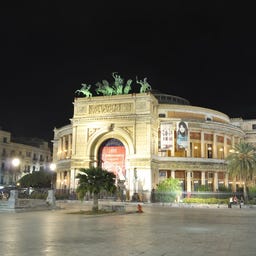
Piazza Ruggero Settimo is one of the most important squares in Palermo and is often referred to by locals, along with the adjacent Piazza Castelnuovo, as Piazza Politeama. In the center of the square stands the monument to Ruggero Settimo, made of Carrara marble and erected in 1865, surrounded by an intricately designed railing by the neoclassical sculptor Benedetto De Lisi.
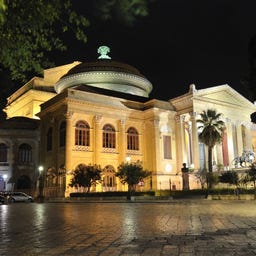
The Piazza Verdi in the historic center of Palermo, also known as Piazza Massimo, was created in the 19th century specifically for the impressive Teatro Massimo Vittorio Emanuele. The construction required not only the demolition of the San Giuliano district but also the partial tearing down of the old city wall, including Porta Maqueda.
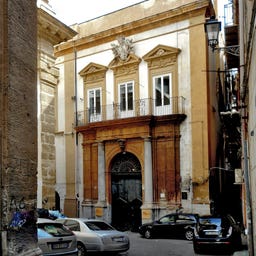
In the heart of Palermo's winding streets stands the Palazzo Natoli, an impressive Baroque building from the 18th century. Built in 1765, this noble palace captivates with its distinctive facade featuring a watchtower, flag, and the coat of arms of the Natoli family. Inside, you’ll find magnificent frescoes by Gioacchino Martorana, commissioned by Marchese Vincenzo Natoli in memory of his wife. An imposing double staircase leads you through the dramatic entrance atrium to the richly decorated rooms, which are now partially used as a hotel and private residences.
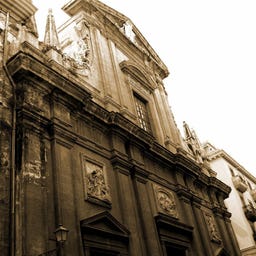
On the magnificent Via Maqueda in the historic center of Palermo stands the Chiesa di Santa Ninfa dei Crociferi, one of the first churches built after the opening of this significant thoroughfare. The Baroque facade designed by Ferdinando Lombardo around 1750 leads you into a single-nave church space with six side chapels, adorned with intricate reliefs and a large painting of Saint Ninfa alongside the patron saints of Palermo.
